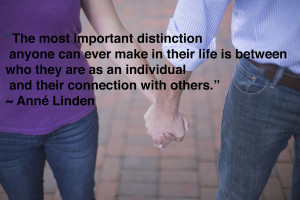 My undergraduate psychology classwork was very research-oriented, not clinical at all. So when I started my Master’s program in the early 90’s, I kept hearing the word “boundaries” when dicussing relationships and I had no idea what the hell people were talking about. The only boundaries I knew about were property lines. The term seems a lot more common now, but it still gets mixed up. And knowing what constitutes healthy boundaries can be pretty confusing.
My undergraduate psychology classwork was very research-oriented, not clinical at all. So when I started my Master’s program in the early 90’s, I kept hearing the word “boundaries” when dicussing relationships and I had no idea what the hell people were talking about. The only boundaries I knew about were property lines. The term seems a lot more common now, but it still gets mixed up. And knowing what constitutes healthy boundaries can be pretty confusing.
One professor described them as this: “Boundaries are where you end, and the other person begins.” I’m sorry, huh? What does that even mean? I was very confused.
It’s probably easier to understand boundaries by first giving examples of bad boundaries. Personal boundaries run along a continuum between overly rigid boundaries (keeping people at arm’s distance and not having very intimate relationships) and overly permeable (too close, not enough separation between yourself and other people) boundaries. Most therapists agree that healthy boundaries are somewhere in the middle – allowing intimacy and closeness, but not enmeshment.
In this post, let’s look at overly rigid boundaries:
People with overly rigid boundaries
tend to be less trusting
don’t reveal much about themselves
don’t let people in easily.
tend to have pretty specific rules about how people should act,
if they think someone in their circle offends or violates them in some way, they’re likely to cut them off completely.
Examples:
Angela in the “The Office” (US version), where she talks about not speaking to her sister for 16 years, and says proudly about her stamina in giving the silent treatment, “Yeah, I’m pretty good.” What’s ironic is that people with rigid boundaries usually end up being controlled by others, although they rarely see it that way.
A housemate of mine in grad school who left a note for us after his first day in the house, “Someone used my yellow cup. I’m starting to feel unsafe.” The culture of the house was that we used each other’s dishware as long as we washed it, so we felt his boundary of “Do Not Touch My Kitchenware!” was a little rigid.
A classmate told me she hated the way I ate my bagel. I ate it into a square, so it was a square around a hole, before eating the whole thing. I told her to get some boundaries. She felt I was crossing her boundary by eating my bagel in a way she didn’t like, and I thought she was crossing my boundary by suggesting she had any say at all in how I ate my bagel. (To her credit, she did eventually admit I was right).
See up there where it says they tend to have lots of rules about how people should behave? They also tend to think these rules are self-evident. Our old housemate could have saved us all a lot of grief if he’d said right off the bat, “Oh, by the way, please don’t touch my kitchen stuff.” We had no idea that was his boundary, but he thought it was obvious.
If you find yourself having to correct people’s behaviors often, or feeling offended and the person who offended you seems genuinely puzzled about what they did wrong, you might have overly rigid boundaries.
There are some situations where it’s OK to have rigid boundaries. To be successful and continue the work we do week after week, therapists have to have clear boundaries. One boundary that I’m pretty rigid about is start and end times of sessions. I feel like it’s important for clients to know how much time they have, and that I’ll be ready for them at their appointment time. Barring emergencies, I’m pretty good about starting each session right on time. That means I have to end on time, as well. Most clients are very respectful of this.
Occasionally I’ll meet someone who has lots of difficulty getting out the door after a session, and continues to talk well after I’ve said the session is over. That’s one reason I build a 10 minute break in between sessions. Sometimes I meet someone who I really have to work with to get them out the door by the next session. In these cases, I know I’ve met someone who might have trouble with boundaries. In fact, they might have overly permeable boundaries, which we’ll talk about in the next post.
